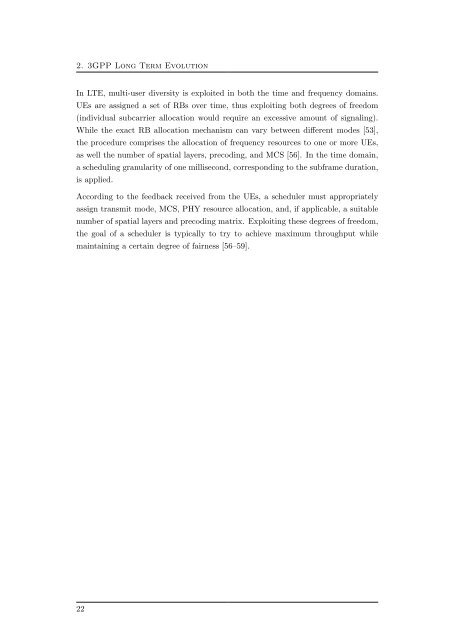System Level Modeling and Optimization of the LTE Downlink
System Level Modeling and Optimization of the LTE Downlink
System Level Modeling and Optimization of the LTE Downlink
- No tags were found...
Create successful ePaper yourself
Turn your PDF publications into a flip-book with our unique Google optimized e-Paper software.
2. 3GPP Long Term EvolutionIn <strong>LTE</strong>, multi-user diversity is exploited in both <strong>the</strong> time <strong>and</strong> frequency domains.UEs are assigned a set <strong>of</strong> RBs over time, thus exploiting both degrees <strong>of</strong> freedom(individual subcarrier allocation would require an excessive amount <strong>of</strong> signaling).While <strong>the</strong> exact RB allocation mechanism can vary between different modes [53],<strong>the</strong> procedure comprises <strong>the</strong> allocation <strong>of</strong> frequency resources to one or more UEs,as well <strong>the</strong> number <strong>of</strong> spatial layers, precoding, <strong>and</strong> MCS [56]. In <strong>the</strong> time domain,a scheduling granularity <strong>of</strong> one millisecond, corresponding to <strong>the</strong> subframe duration,is applied.According to <strong>the</strong> feedback received from <strong>the</strong> UEs, a scheduler must appropriatelyassign transmit mode, MCS, PHY resource allocation, <strong>and</strong>, if applicable, a suitablenumber <strong>of</strong> spatial layers <strong>and</strong> precoding matrix. Exploiting <strong>the</strong>se degrees <strong>of</strong> freedom,<strong>the</strong> goal <strong>of</strong> a scheduler is typically to try to achieve maximum throughput whilemaintaining a certain degree <strong>of</strong> fairness [56–59].22
















